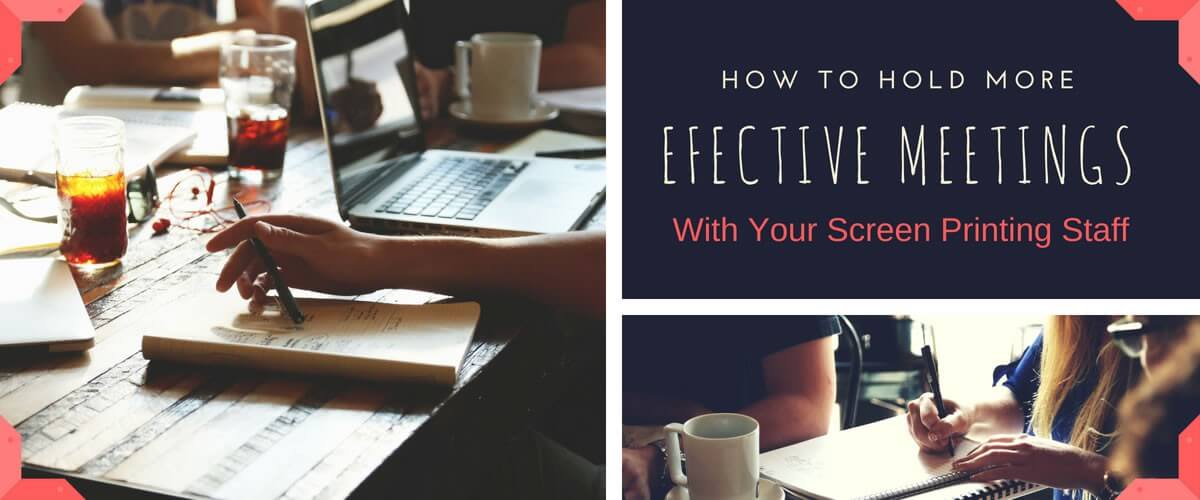No products in the cart.
en

Revolutionizing the screen printing industry through cutting-edge technology and quality service
Phone: +1 847-367-9760
Anatol Equipment Manufacturing Co.
1429 S Shields Dr
Waukegan, IL 60085

Revolutionizing the screen printing industry through cutting-edge technology and quality service
Anatol Equipment Manufacturing Co.
1429 S Shields Dr
Waukegan, IL 60085

Meetings are an essential part of running a business, but you have to be careful they stay on track!
Meetings create a bit of a catch-22 for businesses. They’re necessary for communicating with your staff, but they also can interfere with your screen printing shop’s production pace. The only way to resolve this dilemma is by running meetings with your screen printing staff effectively.
While this is something even the most experienced managers sometimes fail at, you can run more effective meetings in your shop by conscientiously following a few steps every time you schedule a meeting.
Before you schedule any meeting, you need to ask yourself: What makes this meeting necessary? What do I need to communicate with or get feedback from my staff about? The answers to those questions will help you to set a goal for your meeting, which is the first step in holding an effective meeting.
Once you have goals set for your meeting, you need to think about your guest list. Which members of your team are necessary for achieving your meeting’s goals? One common mistake is to issue a blanket invite to every meeting for every employee. This can make meetings longer than they need to be, as more people than necessary weigh in on the topics. It also can lead to employees feeling like meetings are a waste of their time, which means they’ll place less stock in meetings over time. Invite only the people who are necessary to the meeting’s goals. If you have multiple goals involving multiple employees set for the meeting, you might consider holding multiple meetings or alerting your team members which parts of the meeting they are needed for so they don’t need to sit through the entire meeting.
A meeting requires an agenda, and that agenda should be circulated in advance of the meeting. First and foremost, creating the agenda will help you organize your thoughts. It can help you run the meeting in the most coherent manner, and it can keep you from forgetting important details or topics you want to discuss. Circulating the meeting agenda in advance also is crucial; this allows members of your team to prepare for the meeting. When your staff knows which topics will be touched upon in the meeting, they can come prepared with any information you might need them to have, as well as any questions they have on the topics.
Everyone has been in a runaway meeting: The meeting leader loses focus and goes on tangents, or a coworker hijacks the meeting to drone on about other topics. Not only is an off-track meeting frustrating for those in attendance; it’s also a colossal waste of time. As the meeting leader, it is your job to keep the meeting on track. Keep the focus on the agenda, and rein in any employees who begin to sidetrack the meeting topic. If there is an unrelated but important topic that is brought up during the meeting, take note of that topic and make it clear to the employees it concerns that it will be addressed later, outside of the meeting.
You began your meeting with a goal and you used your meeting time to brief your employees on that goal. But how can you really be sure that your meeting will lead to the outcomes your looking for? Send your employees off with clear directives from the meeting. It’s not enough to share information or gather ideas during a meeting; to make a meeting truly effective, everyone on your team needs to understand what is expected from them following the meeting. End your meeting by highlighting what employees should be taking away from the meeting, how they can put those takeaways to good use and how you will be following up with them to ensure that the meeting met its goals.
In the end, a meeting is only as effective as its leader. By following these simple steps every time you conduct a meeting — whether that meeting is a quick, informal morning huddle or an elaborate full-day conference session — you will be setting yourself up for a successful meeting that your screen printing team gains value from and that furthers your goals for your business.
Your message was successfully sent!